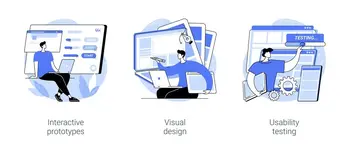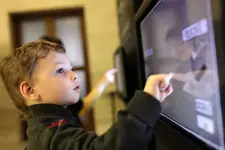
Table of contents
Interactivity is a big word in education these days. Teachers and scientists have found that it’s important for students to be involved in their learning. Interactive learning in lectures means that students get to participate, ask questions, and work with each other. This helps them learn better and remember more.
A
study
by Frontiers in Psychology found that interactivity can help students learn more. It’s especially helpful when combined with active learning methods. Active learning methods are things like group work, interactive teaching, and collaborative learning. These methods help students stay engaged and learn more.
The COVID-19 pandemic made interactive learning even more important. Traditional classrooms had to close, and students had to learn at home. Interactive software and tools like interactive whiteboards, peer learning platforms, and online group projects helped students learn together even though they were apart.
As teachers and scientists are learning more about interactive lectures and they’re finding that it’s a great way to help students learn.
Why Interactivity is Important in Education

Interactive lecturing is a very important part of learning. It helps students pay attention, remember what they learn, and be more engaged in their studies. This section will explain why interactivity is so important and how it affects these things.
1. Attention and Retention
One of the best things about interactive learning is that it keeps students interested. When students are involved in the learning process, they are more likely to pay attention and remember what they are learning. Studies have shown that interactive learning can help students learn up to 60% better than traditional lectures.
2. Student Engagement
Interactivity makes learning more fun and interesting for students. When students are engaged, they are more likely to pay attention and learn the material. Interactive learning methods, like group work, discussions, and hands-on activities, give students a chance to work together and share their ideas. This type of engagement can lead to higher levels of motivation and interest in the subject matter.
3. Active Learning

Interactivity is important for learning. It makes learning more fun and interesting, and it helps students learn better. Interactive learning methods, such as problem-based learning, case studies, and simulations, let students learn by doing. They have to think about what they are learning and solve problems. This makes learning more meaningful and helps students remember what they have learned.
Studies have shown that interactive learning methods can
help students learn more and remember
what they have learned better. They can also help students develop critical thinking and problem-solving skills.
In conclusion, interactivity is an important part of education. It improves students’ learning experience and they remember what they have learned more than in noninteractive classes. Interactive learning methods let students participate actively in the learning process, which leads to higher levels of motivation, interest, and academic achievement.
Types of Interactive Learning
Interactive learning is a way of teaching that makes students do things instead of just listening. It helps them learn by making them think and answer questions. There are many different types of interactive learning, like games, puzzles, and group projects. Each type has its own benefits and advantages.
i. Group Work

Group work is when students work together in small groups to learn. They can solve problems, finish assignments, or talk about ideas. This helps students learn how to work together, talk to each other, and think about things in new ways. It also helps them remember more of what they learn.
A
study
showed that students only remember 5% of what they learn from lectures. But when they participate in group discussions, they remember 50%! This is because group work helps students share their ideas and learn from each other. It also gives them a chance to ask questions and get help from their classmates.
Group work is a great way to learn! It helps students develop important skills that they will need in college and the workforce. It also makes learning more fun and interesting.
ii. Interactive Teaching
Interactive teaching is when teachers use technology and other tools to make learning more fun and interesting for students. This can include things like quizzes, games, simulations, and virtual field trips.
Interactive teaching has been shown to help students learn better. It can increase motivation, interest in learning, and understanding of complex concepts. A
study
found that students who participated in interactive teaching activities scored significantly higher on exams than those who did not.
iii. Peer Learning
Peer learning is when students teach and learn from each other. This can happen in a formal setting, like a classroom, or in an informal setting, like a study group. Peer learning helps students learn better because they are more engaged in the material. They also get to practice their communication and critical thinking skills.
A
study
found that peer learning is one of the most effective teaching methods. Students who participated in peer learning activities had higher test scores and were more likely to graduate from high school.
iv. Learning by Teaching

Learning by teaching is a way to learn by teaching others. Students teach a topic to their friends or younger kids. This helps them understand the material better because they have to explain it to others.
Learning by teaching has been shown to help students understand and remember things better. It also helps them feel more confident and motivated. A
study
found that students who did learning-by-teaching activities did better in school and were more likely to go to college.
In conclusion, interactive learning is a great way to teach. It helps students stay engaged and motivated. By using group work, interactive teaching, peer learning, and learning by teaching, teachers can create a better learning environment for their students.
Tools and Software for Interactive Learning

Interactive learning is a popular way to teach students. It uses technology to make lessons more engaging and interesting. This helps students learn in different ways. In this section, we will look at some popular tools and software for interactive learning.
1. Interactive Whiteboards
Interactive whiteboards are cool tools for making lessons more fun. They let teachers show pictures, videos, and other stuff on the board, and write on it with a pen. Teachers can also change the stuff on the board in real time, which is really cool. A study by the National Center for Education Statistics found that 96% of public schools in the United States have interactive whiteboards in their classrooms. Some popular interactive whiteboard brands are Promethean, SMART, and Mimio.
2. Collaborative Learning Software
Collaborative learning software helps students work together on projects. They can share ideas and give feedback to each other. Some popular collaborative learning software programs are Google Classroom , Microsoft Teams , and Canvas . A study by EdTech Magazine found that 60% of K-12 teachers use collaborative learning software in their classrooms.
3. Project-Based Learning Tools
Project-based learning is a way to teach that makes students learn by doing real-world projects. Project-based learning tools give students the stuff they need to do their projects, like research tools, project management software, and presentation tools. Some popular project-based learning tools are
Trello
,
Prezi
, and
Canva
.
In conclusion, there are many tools and software for interactive learning. Interactive whiteboards, collaborative learning software, and project-based learning tools are just a few examples. Teachers can make learning more fun and interactive for their students by using these tools in their lessons.
Evaluation and Analysis of Interactive Learning

Evaluation and analysis are important parts of interactive learning. We need to make sure that interactive learning methods are working well and helping students learn. Evaluation helps us find the good and bad parts of interactive learning methods, and gives us ideas for how to make them better.
One of the best things about interactive learning is that it gives students instant feedback. This feedback helps students understand their strengths and weaknesses, and work on them. Evaluation of interactive learning methods can be done with surveys, quizzes, and tests. These evaluations help us measure how well interactive learning methods are working, and give us ideas for how to make them better.
Analysis of interactive learning methods involves using data to evaluate how well these methods are working. Data analysis can help us find areas where students are struggling, and give us ideas for how to make them better. Analysis of interactive learning methods can be done with software that tracks student progress and gives us insights into their learning patterns.
ICT (information and communication technology) has played a big role in the evaluation and analysis of interactive learning methods. With technology, we can now track student progress and give instant feedback. Technology has also made it easier to collect data and analyze it to find areas where students are struggling.
A
study
showed that students only remember 5% of the information presented in lectures, compared to 50% when they are involved in a discussion, and 75% when they practice what they have learned. This statistic shows that interactive learning methods are more effective than traditional lecture-based learning.
In conclusion, evaluation and analysis are important parts of interactive learning. They help us find the good and bad parts of interactive learning methods, and give us ideas for how to make them better. The use of ICT has played a big role in the evaluation and analysis of interactive learning methods. Interactive learning methods have been shown to be more effective than traditional lecture-based learning.
The Impact of the COVID-19 Pandemic on Interactive Learning
The COVID-19 pandemic has made learning hard. The sudden switch to online classes has messed up the usual way of teaching. One of the things that is most affected is interactive learning. This is because interactive learning needs students and teachers to work together in person.
i. Online Learning

The COVID-19 pandemic made schools move their classes online. This led to more use of virtual learning environments and video conferencing tools. These tools helped students learn, but they also made it harder for students and teachers to talk and work together in real time. This led to less interactive learning. A study by McKinsey & Company found that 70% of colleges said students were less engaged during the pandemic.
ii. Virtual Presentations
Virtual presentations have become a popular way to give presentations instead of in person during the pandemic. They have some advantages, like being able to share pictures and videos with more people, but they can also make it harder to learn.
Virtual presentations don’t have the same face-to-face interaction and feedback that is important for learning. This can make students less engaged and less likely to participate, and it can also make it harder for teachers to give good feedback.
To fix this, teachers have had to find new ways to make virtual presentations more interactive. They have used breakout rooms, polls, and other tools to let students talk to each other and do group activities in real time.
In conclusion, the COVID-19 pandemic has changed how we learn. Virtual presentations and online learning have made it possible to keep learning, but they have also made it harder to interact with teachers and other students. Teachers have had to find new ways to make virtual presentations more interactive so that students can still learn and participate.














